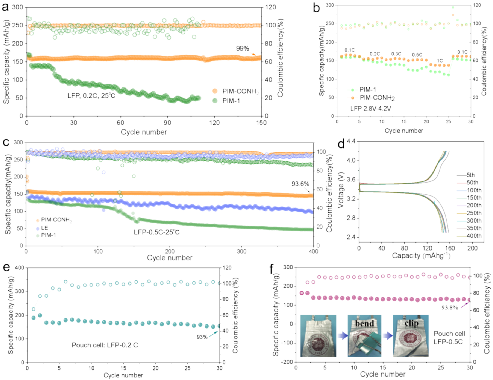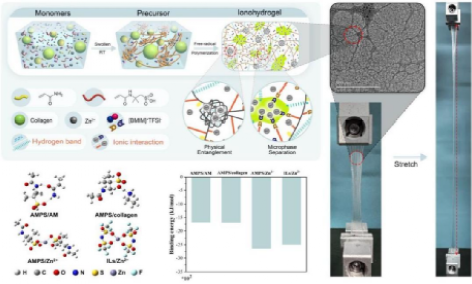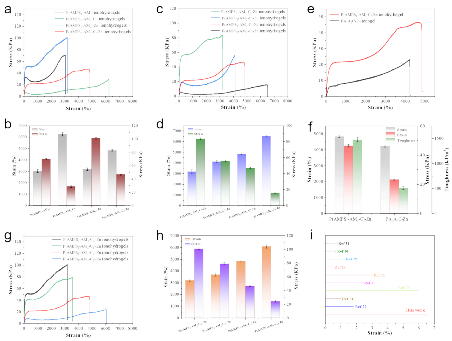Porous solid-state polymer electrolytes have emerged as highly promising candidates for next-generation batteries due to their outstanding safety, excellent interfacial compatibility, and efficient ion transport properties. However, how to systematically regulate the solvation microenvironment of lithium ions (Li⁺) within the microporous structure of inherently microporous polymers (PIMs) to significantly enhance lithium ion conductivity remains an unexplored area. In this work, we propose a novel strategy for constructing microenvironment engineering within microporous channels. By creating interconnected sub-nanometer-scale ion transport pathways within the rigid and twisted backbone of PIMs, we achieve precise control over the interactions between lithium ions and solvents in the pore microenvironment.

Recently, the PIM-CONH2 polymer electrolyte developed by Professor Tian Lei's research group at Shenzhen University has demonstrated excellent performance. Through dual optimization, the porous polymer electrolyte achieves outstanding room-temperature ionic conductivity (1.08×10-3S cm-1), a high lithium-ion transference number (Li+= 0.88), and a wide electrochemical window (5.2 V). These superior electrochemical properties enable the assembled Li-Li symmetric cell to maintain stable deposition/stripping over 1,500 hours at 0.1 mA cm-2. Consequently, the LFP|PIM-CONH2|Li cell delivers an initial discharge specific capacity of 158.2 mAh·g⁻¹ at 0.5 C and 25°C, with a capacity retention rate of 93.6% after 400 cycles. Notably, the assembled pouch cell retains a high discharge specific capacity of 139.2 mAh g⁻¹ even after folding and cutting at 0.5 C. Furthermore, the introduction of the non-flammable PIM-CONH2 electrolyte represents a significant advancement, facilitating the transition toward practical applications of high-safety and high-energy-density solid-state batteries.
The relevant research achievements were published in the top international journal《ACS Nano》under the title "The Regulation of Ion Transport Microenvironment in Micropores to Precisely Construct Porous Polymer Electrolytes for Solid-State Lithium-Metal Batteries." Lu Songxin, a first-year graduate student, is the first author of the paper.

Figure 1. The design of porous polymer electrolyte (PIM-CONH2) and understanding of its microporous microenvironment. (a) Schematic diagram of ion transport in the microporous environment. (b) Synthetic routes of PIM polymers. (c) Schematic diagram of the comparison of the microporous microenvironment of PIMs electrolytes before and after modification. (d) Different structural PIMs molecular configurations and lithium ion coordination sites.

Figure 2. Performance of Solid-State Lithium Metal Batteries. (a) The cycling performance of LFP|PIM-1|Li, LFP|PIM-CONH2|Li at 0.2 C rate and 25℃. (b) Rate performance of LFP|PIM-1|Li and LFP|PIM-CONH2|Li. (c) The cycling performance of LFP|PIM-1|Li, LFP|PIM-CONH2|Li, and LFP|LE|Li at 0.5 C rate and 25℃. (d) Charge discharge curves of LFP|PIM-CONH2|Li at 0.5 C and 25℃. (e) The cycling performance of LFP|PIM-CONH2|Li pouch cells at 0.2 C and 25℃. (f) The cycling performance of the LFP|PIM-CONH2|Li pouch cell after folding and cutting under the conditions of 0.5 C rate and 25°C.
DOI: https://doi.org/10.1021/acsnano.5c07105
Ionic gels exhibit high ionic conductivity, excellent thermal stability, chemical stability, electrochemical stability, and flexibility, making them ideal candidate materials for replacing hydrogels. However, their long-term reliability in terms of fatigue resistance and impact resistance remains a key challenge hindering practical applications, and effective strategies to address this issue are still needed.

Recently, the research group led by Professor Lei Tian from the College of Chemistry and Environmental Engineering at Shenzhen University, inspired by the water-retention properties of collagen in human skin, proposed a multi-non-covalent interaction strategy to achieve synergistic effects of physical entanglement and microphase separation. In addition, the introduction of collagen, a biological macromolecule, generated cohesive forces within the microphases and multiple hydrogen bonds. The resulting ionic hydrogel exhibits unprecedented properties, including ultra-stretchability (>6500%), impact resistance, and excellent ionic conductivity (2.18 mS/cm). It can stably maintain swelling up to 300 times its own volume and resist puncture by sharp objects. This work, titled "Ultrastretchable, Crack-Propagation-Resistant, and Impact-Resistant Ionic Conductive Ionohydrogels," has been published in 《Macromolecules》. The first authors of the paper are Master's students Jiahui He and Haiyu Huang, both in their first year of graduate study.

Figure 3. Design principle and preparation of ultra-stretchable P(AMPS-AM-C)-Zn ion hydrogel

Figure 4 Mechanical properties of P(AMPS-AM-C)-Zn hydrogel
DOI:https://pubs.acs.org/doi/10.1021/acs.macromol.5c00072
Rubber is renowned for its exceptional mechanical properties, including outstanding elasticity, tensile strength, and low cost. However, traditional rubber lacks ionic conductivity, which significantly limits its application in solid-state electrolytes. In this work, we propose the concept of ion-conductive rubber (ICR) electrolytes to enhance the ionic conductivity of conventional rubber and create a quasi-solid-state polymer electrolyte (QPE) suitable for lithium metal batteries.

Recently, the ICR QPE polymer electrolyte developed by Professor Tian Lei's research group at Shenzhen University demonstrated remarkable elasticity, ensuring excellent dynamic contact during lithium stripping and plating processes. As a result, the assembled symmetric cells exhibited low polarization voltage and highly stable lithium stripping/plating cycles, maintaining performance for over 1,300 hours at a current density of 0.1 mA cm⁻⟡. Additionally, the ICR QPE exhibited an ionic conductivity of 0.4×10⁻³ S cm⁻¹ at room temperature and an ultrahigh Li⁺ transference number of 0.758. Furthermore, the LFP|ICR QPE|Li cell assembled with this electrolyte showed excellent long-term cycling stability at 0.5 C and 25 °C, achieving an average Coulombic efficiency of 99.6% after 600 cycles. The proposed ICR QPE overcomes the traditional challenges of rubbery ion conduction, and its unique low-cost characteristics, superior mechanical properties, and outstanding ionic conductivity provide a promising solution for long-cycle-stable solid-state lithium metal batteries. This work has been published in the international top-tier journal 《Energy Storage Materials》, with Yin Gang as the first author.

Figure 5. Preparation and characterization of ICR (a) Schematic illustration of the ICR preparation process (b) Fourier transform infrared spectroscopy (FTIR) spectra of pure HFBA, PEGDA, rubber, and ICR (c) Thermogravimetric analysis (TGA) curves of ICR and R-6F (d) Small-angle scattering pattern of ICR (e) Two-dimensional magnetic resonance imaging (MR) image of ICR (f) Stress-strain curves of ICR at different crosslinker addition ratios (g) Puncture resistance comparison of ICR at different crosslinker addition ratios (h) Digital photographs demonstrating the puncture resistance of ICR

Figure 6. Li⁺ transport properties and electrochemical characteristics of ICR QPE. (a) Impedance plots of ICR QPE at different temperatures. (b) Arrhenius plots of ionic conductivity for ICR QPE and R-6F QPE. (c) Bar chart comparing the ionic conductivity of ICR QPE and R-6F QPE at room temperature. (d) Polarization curve of Li|ICR QPE|Li battery and initial/steady-state impedance plots. (e) Bar chart comparing the lithium-ion transference numbers of ICR QPE and R-6F QPE. (f) LSV curves of ICR QPE and R-6F QPE. (g) HOMO and LUMO energy levels of HFBA, pure rubber, ICR QPE, and R-6F. (h) Comparison of ionic conductivity and conductivity between ICR QPE and other materials.
DOI:https://doi.org/10.1016/j.ensm.2025.104244
